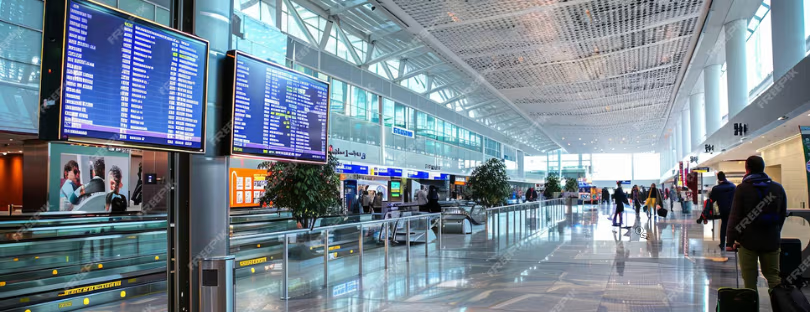
Top Airport Management Software Solutions Powering Modern Aviation
Let’s be real: when you think about airports, your mind probably jumps to long security lines, the thrill (or dread) of take-off, or maybe overpriced sandwiches. But behind all the hustle, flight announcements, and baggage belts is something far more invisible but essential: airport management software.
Yep. While you’re sipping overpriced coffee waiting for boarding, software is working overtime to make sure that plane gets you to your destination on time, your luggage doesn’t get lost (hopefully), and no runway traffic jam causes a domino delay.
So let’s pull back the curtain and talk about the companies building that digital backbone. These aren’t just tech vendors — they’re the quiet orchestrators of every smooth (and not-so-smooth) airport experience.
Why Airport Management Software Matters
Airports aren’t just buildings with gates. They’re massive ecosystems — coordinating thousands of flights, employees, pieces of luggage, passengers, and vehicles daily. Imagine doing all of that with spreadsheets. (Spoiler: some still do. Yikes.)
That’s where airport management systems (AMS) come in. From flight scheduling and gate assignments to passenger flow and resource allocation, AMS helps keep the entire operation running with precision.
Think of it like mission control for every airport function — but with better user interfaces (we hope).
What Does Airport Management Software Actually Do?
A lot. But to simplify, here are some of the core modules it typically includes:
- Flight information display systems (FIDS) – Real-time updates for passengers.
- Resource management – Allocating gates, baggage belts, and runways.
- Operations control – Monitoring airport activity minute-by-minute.
- Passenger flow tracking – To avoid overcrowding and security bottlenecks.
- Billing & invoicing – For airport services used by airlines (think parking, fuel, slot usage).
- Maintenance and facilities management – Keeping everything in working order.
- Security and compliance tools – Meeting international aviation standards.
And now that airports are becoming increasingly digital, many systems also integrate AI, machine learning, and IoT sensors for real-time decision-making and predictive insights.
The Big Names in Airport Management Software
Let’s look at the players actually building this tech. Some names you’ll know. Others are more behind-the-scenes — but they’re all shaping how airports work today.
1. SITA
If there were a celebrity in this space, it’d be SITA. They provide IT and communication services to the air transport industry — powering over 1,000 airports worldwide.
Their SITA Airport Management suite handles everything from flight management and operational control to collaborative decision-making. And they’re really pushing smart airport tech — integrating biometric boarding, self-service kiosks, and baggage tracking into their platform.
Bonus: SITA is actually a cooperative, meaning it’s owned by airlines — so it’s very plugged into real aviation needs.
2. Amadeus Airport IT
Yes, the same Amadeus you’ve probably used to book flights. But they don’t just serve travel agencies and airlines — they also provide high-end solutions for airport operators.
Their Amadeus Airport Operational Database (AODB) is like the heartbeat of the airport. It’s designed for flight tracking, real-time data sharing, and performance monitoring.
Amadeus also offers Airport Common Use Service (ACUS), which virtualizes the check-in and boarding process, reducing IT hardware requirements. It’s very plug-and-play, which is great for airports trying to modernize without breaking everything.
3. ADB SAFEGATE
These guys are all about integrated airside solutions. Their systems handle airfield lighting, gate management, and surface guidance. If it moves on a runway or taxiway, ADB SAFEGATE is probably helping track and manage it.
Their OneControl platform combines surveillance, guidance, and control data into one interface — giving air traffic controllers and airport ops staff a comprehensive view.
What’s interesting is their focus on turnaround management — basically squeezing every second of efficiency between flights.
4. Honeywell
Surprised? While better known for aerospace and industrial systems, Honeywell also delivers airport management tools, especially when it comes to building automation and environmental monitoring.
Think heating, ventilation, energy usage, and smart lighting — all tied into a central dashboard. In today’s eco-conscious world, Honeywell helps airports improve energy efficiency and reduce operational costs.
5. Indra
A global player based in Spain, Indra is behind InPlan, an integrated airport operations platform. Their software supports collaborative decision-making between stakeholders — airlines, ground handlers, and air traffic control — to enhance punctuality and resource use.
Indra also specializes in air traffic management (ATM) systems, so they offer a unique blend of both airside and landside solutions.
6. Inform GmbH
This German company has a deep niche: optimization software for complex operations. At airports, their GroundStar suite focuses on workforce planning, real-time turnaround coordination, and disruption management.
Airports love GroundStar because it’s modular, scalable, and analytics-heavy — great for hubs that need to fine-tune every minute of ground operations.
What About Smaller Airports?
Here’s the truth: not every airport has the budget of Heathrow or Changi. Many regional or domestic airports need lighter, cloud-based, and budget-friendly options.
That’s where companies like Damarel, TAV Technologies, and Azinq come in. They provide modular tools for flight info, check-in desks, and billing — often with SaaS pricing models that smaller airports can manage.
And then there’s a whole wave of startups building innovative plug-ins and mobile-first tools to improve passenger services, queue management, and data reporting.
The Big Trends Shaping the Industry
Airport management is evolving fast. Here are some key trends software companies are rushing to support:
- Biometric Identity Verification – Think facial recognition at boarding gates.
- Predictive Maintenance – Using sensors and AI to reduce equipment downtime.
- Sustainability Dashboards – Tracking emissions, fuel usage, and waste.
- Digital Twins – Creating virtual replicas of airport systems to simulate improvements.
- Cybersecurity – As airports digitize, they become targets. AMS providers are beefing up defenses.
Final Boarding Call
Airport management software may not be something passengers think about — but it’s absolutely critical. These platforms are what keep the planes flying, the passengers flowing, and the coffee machines working (yes, even those need monitoring).
The companies behind this tech — from giants like SITA and Amadeus to specialized providers like Inform and Damarel — are helping airports run smoother, smarter, and safer.
Next time you’re breezing through a security checkpoint or watching your bag magically appear on the carousel, take a second to thank the digital infrastructure quietly working behind the scenes.
Because no matter how modern or boutique an airport looks, without the right software, it’s just a very expensive waiting room.









